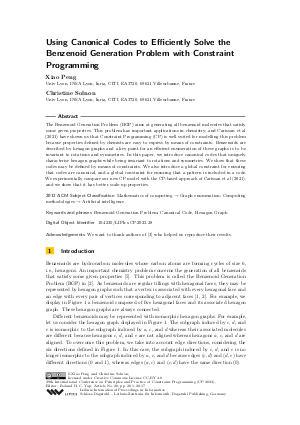@InProceedings{peng_et_al:LIPIcs.CP.2023.28,
author = {Peng, Xiao and Solnon, Christine},
title = {{Using Canonical Codes to Efficiently Solve the Benzenoid Generation Problem with Constraint Programming}},
booktitle = {29th International Conference on Principles and Practice of Constraint Programming (CP 2023)},
pages = {28:1--28:17},
series = {Leibniz International Proceedings in Informatics (LIPIcs)},
ISBN = {978-3-95977-300-3},
ISSN = {1868-8969},
year = {2023},
volume = {280},
editor = {Yap, Roland H. C.},
publisher = {Schloss Dagstuhl -- Leibniz-Zentrum f{\"u}r Informatik},
address = {Dagstuhl, Germany},
URL = {https://drops.dagstuhl.de/entities/document/10.4230/LIPIcs.CP.2023.28},
URN = {urn:nbn:de:0030-drops-190650},
doi = {10.4230/LIPIcs.CP.2023.28},
annote = {Keywords: Benzenoid Generation Problem, Canonical Code, Hexagon Graph}
}

 Creative Commons Attribution 4.0 International license
Creative Commons Attribution 4.0 International license









